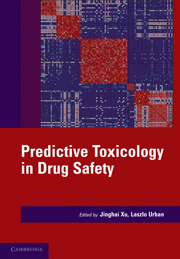Book contents
- Frontmatter
- Contents
- Contributors
- Prologue – Predictive toxicology: a new chapter in drug safety evaluation
- PREDICTIVE TOXICOLOGY IN DRUG SAFETY
- I SPECIFIC AREAS OF PREDICTIVE TOXICOLOGY
- 1 The human predictive value of combined animal toxicity testing: current state and emerging approaches
- 2 Screening approaches for genetic toxicity
- 3 Cardiac safety
- 4 Predicting drug-induced liver injury: safer patients or safer drugs?
- 5 In vitro evaluation of metabolic drug–drug interactions
- 6 Reliability of reactive metabolite and covalent binding assessments in prediction of idiosyncratic drug toxicity
- 7 Immunotoxicity: technologies for predicting immune stimulation, a focus on nucleic acids and haptens
- 8 Predictive models for neurotoxicity assessment
- 9 De-risking developmental toxicity-mediated drug attrition in the pharmaceutical industry
- II INTEGRATED APPROACHES OF PREDICTIVE TOXICOLOGY
- Epilogue
- Index
- Plate section
- References
2 - Screening approaches for genetic toxicity
from I - SPECIFIC AREAS OF PREDICTIVE TOXICOLOGY
Published online by Cambridge University Press: 06 December 2010
- Frontmatter
- Contents
- Contributors
- Prologue – Predictive toxicology: a new chapter in drug safety evaluation
- PREDICTIVE TOXICOLOGY IN DRUG SAFETY
- I SPECIFIC AREAS OF PREDICTIVE TOXICOLOGY
- 1 The human predictive value of combined animal toxicity testing: current state and emerging approaches
- 2 Screening approaches for genetic toxicity
- 3 Cardiac safety
- 4 Predicting drug-induced liver injury: safer patients or safer drugs?
- 5 In vitro evaluation of metabolic drug–drug interactions
- 6 Reliability of reactive metabolite and covalent binding assessments in prediction of idiosyncratic drug toxicity
- 7 Immunotoxicity: technologies for predicting immune stimulation, a focus on nucleic acids and haptens
- 8 Predictive models for neurotoxicity assessment
- 9 De-risking developmental toxicity-mediated drug attrition in the pharmaceutical industry
- II INTEGRATED APPROACHES OF PREDICTIVE TOXICOLOGY
- Epilogue
- Index
- Plate section
- References
Summary
INTRODUCTION
Assessing human cancer risk associated with exposure to chemicals is an essential component of the safety assessment paradigm for drugs, cosmetics, and industrial chemicals. The current testing paradigm mainly relies on in vitro genotoxicity testing followed by 2-year carcinogenicity bioassays in mice and rats. Because of the technical complexity, high costs, and animal usage associated with 2-year bioassays, the genetic toxicology battery has been designed to be highly sensitive in predicting chemical carcinogenicity. In fact, the genotoxicity testing is used as a surrogate for carcinogenicity testing and is required for initiation of clinical trials and for most industrial chemicals. Since the beginning of genotoxicity testing in the early 1970s, many different test systems have been developed and used. Since no single test is capable of detecting all genotoxic agents, present routine genotoxicity evaluation of pharmaceutical compounds incorporates a standard battery of in vitro and in vivo assays. These tests include (a) bacterial reverse-mutation tests, (b) in vitro tests for chromosomal damage (cytogenetic assays and in vitro mouse lymphoma thymidine kinase assay), and (c) an in vivo test for chromosomal damage (micronucleus test). To further enhance human genotoxic risk assessment, the international ICH working group together with other scientific groups have also suggested additional tests such as the measurement of DNA adducts, DNA strand breaks, DNA repair, and recombination to complement the standard battery in certain cases.
Recent progress in molecular biology, genomics, and bioinformatics has revolutionized drug discovery research.
- Type
- Chapter
- Information
- Predictive Toxicology in Drug Safety , pp. 18 - 33Publisher: Cambridge University PressPrint publication year: 2010
References
- 1
- Cited by



